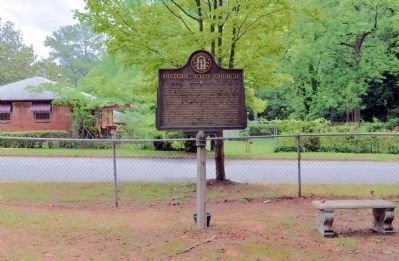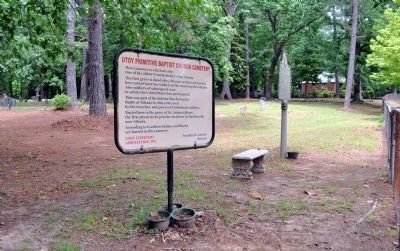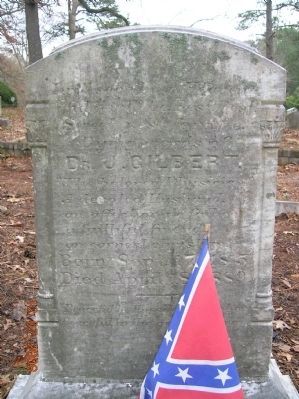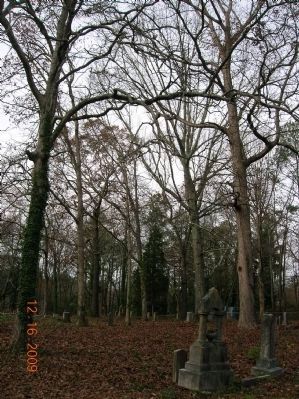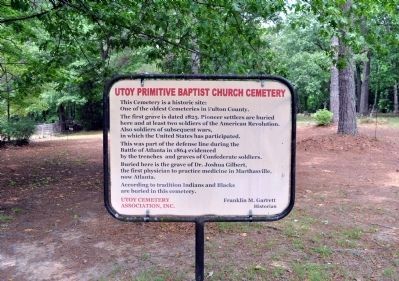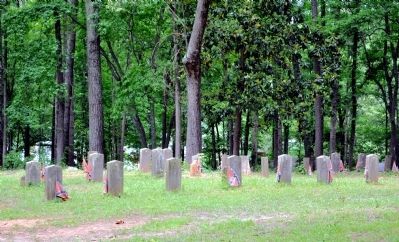Venetian Hills in Atlanta in Fulton County, Georgia — The American South (South Atlantic)
Historic Utoy Church
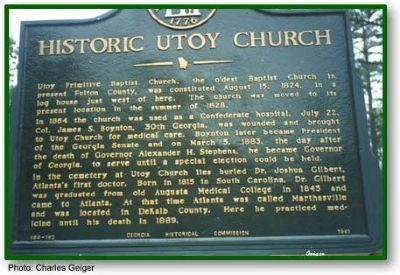
Photographed By Charles Geiger, Photographer
1. Historic Utoy Church Marker
The Marker is inside the Cemetery but can be seen from the road. A history of the site was also prepared by Franklin Garrett, Historian of the Atlanta Historical Society (Deceased). It is maintained by volunteers of the Utoy Cemetary Association. Contact [email protected] to help in maintaining this historic private cemetery.
In 1864 the church was used as a Confederate hospital. July 22, Col. James S. Boynton, 30th Georgia, was wounded and brought to Utoy Church for medical care. Boynton later became President of the Georgia Senate and on March 5, 1883, the day after the death of Governor Alexander H. Stephens, he became of Governor of Georgia, to serve until a special election could be held.
In the cemetery at Utoy Church lies buried Dr. Joshua Gilbert, Atlanta's first doctor. Born in 1815 in South Carolina, Dr. Gilbert was graduated from old Augusta Medical College in 1845 and came to Atlanta. At that time Atlanta was called Marthasville and was located in DeKalb County. Here he practiced medicine until his death in 1889.
Erected 1961 by Georgia Historical Commission. (Marker Number 060-192.)
Topics and series. This historical marker is listed in these topic lists: Cemeteries & Burial Sites • Churches & Religion • War, US Civil • War, US Revolutionary. In addition, it is included in the Georgia Historical Society series list. A significant historical month for this entry is March 1907.
Location. 33° 42.94′ N, 84° 26.98′ W. Marker is in Atlanta, Georgia, in Fulton County. It is in Venetian Hills. Marker is at the intersection of Cahaba Drive and Bayberry Drive, on the left when traveling north on Cahaba Drive. The Property is Owned by the Utoy Cemetery Association a voluntary organization dedicated to the preservation of the Cemetery. Touch for map. Marker is in this post office area: Atlanta GA 30311, United States of America. Touch for directions.
Other nearby markers. At least 8 other markers are within 2 miles of this marker, measured as the crow flies. The Extended Siege Lines (approx. ¾ mile away); Confederate Entrenchments: 1864 (approx. 0.9 miles away); Fort McPherson (approx. 1.3 miles away); Kilpatrick’s Cavalry on the Newnan Stage Road (approx. 1.3 miles away); Battle of Utoy Creek (approx. 1.4 miles away); The Embattled Ridge (approx. 1.4 miles away); a different marker also named Battle of Utoy Creek (approx. 1.8 miles away); Third Division 23rd Corps Attack / Second Division 23rd Corps Attack (approx. 1.8 miles away). Touch for a list and map of all markers in Atlanta.
More about this marker. Several Hundred union solders were buried here during the the siege of Atlanta in 1864. In 1866 they were moved to the Present National Cemetery in Marietta and they were identified. The Confederate unknown soldiers are from Major General William B. Bates Division CSA which had been attached
to LT Gen S.D. Lees Corps for the defense of the railroads running to East Point. (Submitted by Mr. Franklin Garrett, Historian Atlanta Historical Society)
Regarding Historic Utoy Church. Over a hundred Union solders who died of their wounds despite treatment were buried here during the the siege of Atlanta in 1864. In 1866 they were moved to the Present National Cemetery in Marietta. The Confederate unknown soldiers are from Major General William B. Bates Division CSA which had been attached to LT Gen S.D. Lees Corps for the defense of the railroads running to East Point. Kentucky, Tennessee, Florida and Georgia Troops who were unidentified.
Related markers. Click here for a list of markers that are related to this marker. To better understand the relationship, study each marker in the order shown.
Additional commentary.
1. Colonel Boynton Commanding the 30th GA Infantry Regiment
Colonel Boynton commanding the 30th GA Infantry Regiment assigned to Brigadier General H. R. Jacksons,(Georgia) Brigade of Bates Division was actually wounded at the battle of Utoy Creek, and treated at the Field Hospital operated here at the Utoy Church.
Jacksons Brigade was posted 3/4 of a mile West of the Utoy Primative Baptist Church during the Battle of Utoy Creek
on 5-6 August 1864. The Date on the marker (July 22) is in error.
— Submitted May 12, 2009, by Lieutenant Colonel Perry Bennett, Army Historian of Atlanta, Georgia.
Additional keywords. Battle of Utoy Creek, Siege of East Point, Jesse Childress, Revolutionary War Soldiers, Bate's Division, Primitive Baptist Church, Dr Samuel Gilbert, Dr. Joshua Gilbert, COL James S. Boynton, Uptoy Indian Missionary's 1819
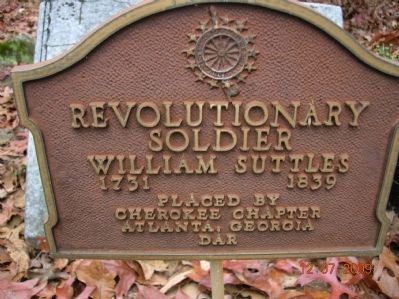
Photographed By T. J. White, circa 2010
5. Historic Utoy Church Marker
Bronze DAR marker at the grave of Revolutionary War veteran William Suttles (ancestor of the submitter). Suttles was born in 1731 in King George County, Virginia, and died on 23 January, 1839, in DeKalb (later Fulton) County, Georgia, at the age of 107. He also served in the French and Indian Wars, and was captured by Indians at Braddock's Retreat. According to tradition, he obtained his freedom by repairing the Indians' guns (he was a gunsmith); by this means he obtained their confidence, and eventually they let him go out to hunt alone; on one such occasion he managed to escape and made his way back to Virginia and his family. (Source: "The Settle-Suttle Family," by Col. Wm. Emmett Reese)
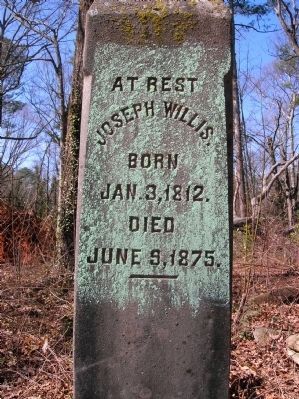
Photographed By T. J. White, circa 2010
6. Historic Utoy Church Marker
Grave of "Squire" Joseph Willis Jr. (1812-1875) (great-uncle of the submitter), for whom Atlanta's "Willis Mill Road SW" was named. Part of the Civil War "Battle of Utoy Creek" took place on Willis' property, and he and his large extended family were eyewitnesses to the heavy fighting in August, 1864. Willis held the office of Justice of the Peace, an indicator of the esteem in which he was held by the early citizenry of DeKalb and Fulton Counties. He was also a grandson of Revolutionary veteran William Suttles (1731-1839).
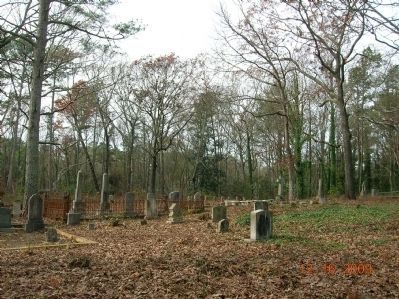
Photographed By T. J. White, December 16, 2009
8. Historic Utoy Church Cemetery
The William W. White plot in the foreground (with its rusted antique fence); in the distance can be seen several of the graves of unknown Confederate casualties of the Battle of Utoy Creek, who died from wounds treated at the church (which was used as a field hospital). The doctor and nurse who treated the soldiers also lie buried here. The doctor was Dr. Joshua Gilbert (Atlanta's first physician) and the nurse was a Miss Sally Hendon.

Photographed By T. J. White, circa 2010
9. Fence
Rusted antique Victorian iron fence gate surrounding the family plot of William Wilson White (1800-1895) and his wife Elizabeth "Betsy" Willis (1801-1883) (ancestors of the submitter), who were the longest-lived of all of Utoy Church's members, he living to be 94, and she living to be 82. They are recorded in the Minute Books of Utoy Church (at the Georgia State Archives).
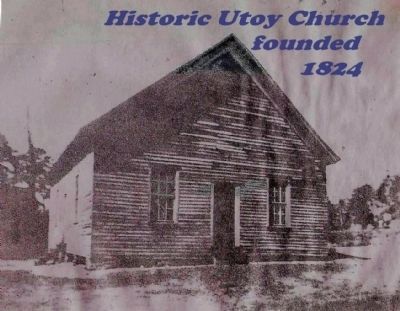
Photographed By T. J. White, circa 1949
10. Historic Utoy Church in 1949, Before Remodelling
This is how the historic antebellum church appeared throughout the 19th Century--with bare, unpainted clapboards. During the years 1958-59, it was unfortunately extensively remodelled, with the addition of a brick veneer exterior, a front porch, a new roof, new windows and front door, and a rear baptistry. Amazingly, however, the original unpainted clapboards are still there, underneath the brick.
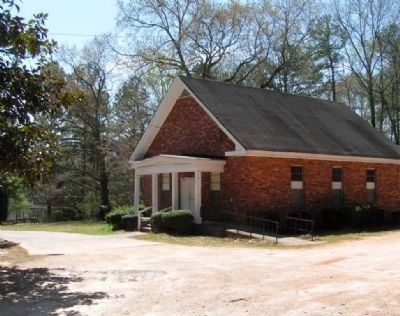
Photographed By T. J. White, circa 2009
11. Historic Utoy Church as it appears today
This will show how extensively the historic church was forever altered in 1958-59 (by comparison with the photo from 1949). Structurally, the building is essentially still the same as the one that witnessed so much history.
Credits. This page was last revised on February 8, 2023. It was originally submitted on July 6, 2008, by Lieutenant Colonel Perry Bennett, Army Historian of Atlanta, Georgia. This page has been viewed 3,888 times since then and 65 times this year. Photos: 1. submitted on July 6, 2008, by Lieutenant Colonel Perry Bennett, Army Historian of Atlanta, Georgia. 2, 3. submitted on May 14, 2012, by David Seibert of Sandy Springs, Georgia. 4, 5, 6, 7, 8, 9, 10, 11. submitted on August 10, 2010, by T. J. White of Forest Park, Georgia. 12, 13. submitted on May 14, 2012, by David Seibert of Sandy Springs, Georgia. • Craig Swain was the editor who published this page.
